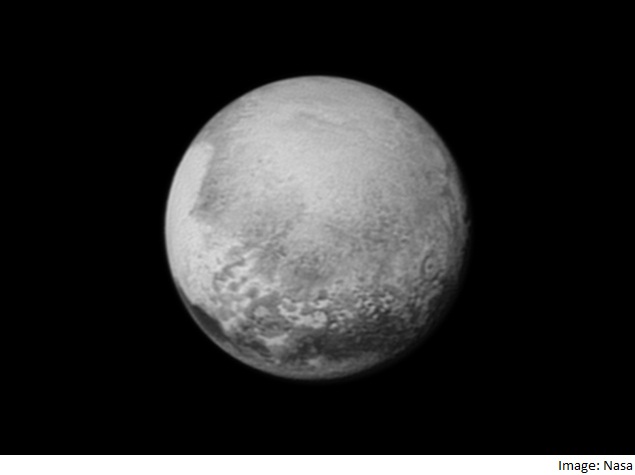- Home
- Science
- Science News
- Nasa Counts Down to Nail Biter Pluto Flyby on Tuesday
Nasa Counts Down to Nail-Biter Pluto Flyby on Tuesday

An unmanned Nasa spacecraft is hurtling into the unknown, and Tuesday will make a close shave past Pluto, allowing scientists a close glimpse of the dwarf planet's surface for the first time.
But there were some jitters Monday as the $700 million (roughly Rs. 4,448 crores) spacecraft, called New Horizons, sped toward Pluto, the last undiscovered frontier in the solar system.
According to principal investigator Alan Stern, there is a one in 10,000 chance that the spacecraft could be lost in a collision with debris around Pluto, long considered the farthest planet from the sun until it was reclassified as a dwarf planet in 2006.
The closest approach is set for Tuesday at 7:49 am (11:49am GMT, or 5:19pm IST), when the piano-sized spacecraft shaves by Pluto's surface at a speed of 30,800 miles (49,570 kilometers) per hour.
The first spacecraft to visit an unexplored planet since the Nasa Voyager missions of the 1970s will be busy snapping pictures and collecting data, and will phone home later.
New Horizons will send a signal to Earth at 4:20pm (8:20pm GMT, or 1:50am IST, Wednesday). It will take nearly five hours to reach scientists.
That means NASA won't announce until about 13 hours after the flyby, at 9:02pm (1:02am GMT, Wednesday, or 6:32am IST, Wednesday), whether or not the spacecraft survived the high-speed encounter.
"While I don't lose sleep over this, the fact is, tomorrow evening is going to be a little bit of drama," said Stern.
"Until we pass that point tomorrow evening we won't really know with certainty that we cleared the system and that there were no debris strikes."
Shooting gallery
Stern said experts have searched for potential debris and haven't found any of concern.
But spaceflight is a risky business, and Stern described the Kuiper Belt, where Pluto resides on the edge of the solar system, as "more or less a shooting gallery, with lots of small primordial comets and other things much smaller than Pluto."
Never before has a spacecraft ventured into the Kuiper Belt, and New Horizons has been on its way there for more than nine years a journey of some three billion miles.
"We are flying into the unknown," Stern told reporters.
New discoveries
What is currently known about Pluto could probably fit on a few index cards, Stern has said. New Horizons' data will enable entire textbooks to be written about the mysterious celestial body.
Already, the pioneering Nasa mission has confirmed the existence of a polar ice cap on Pluto, and found nitrogen escaping from Pluto's atmosphere.
Stern also said it appears slightly larger than previously thought, with a radius of 736 miles (1,185 kilometers).
Stunning visual features are coming into focus for the first time, including a light-colored heart shape nestled near a dark spot nicknamed "The Whale."
And more detail is expected in the days to come, according to deputy project scientist Cathy Olkin.
"Right now, we are taking data that if you could transport (New York's) Central Park to Pluto you would be able to identify the ponds in Central Park, that is the kind of resolution we will be getting," she said.
"We are going to be making stereo maps so that we can see how tall the mountains are and how low the valleys are," Olkin added.
Fossil of solar system
Next, scientists will watch the sun rise and set behind Pluto, use New Horizons' seven instruments to create a full picture of Pluto and its five moons, and study the dust in the outer solar system and the atmosphere around Pluto and its largest moon, Charon.
Learning more about Pluto has captured the public's attention because it speaks to the origins of the Earth and the larger questions of whether life could exist elsewhere, according to Nasa's John Grunsfeld, associate administrator of Nasa's science mission directorate.
"The Pluto system is a fossil remnant of the beginnings of our solar system," Grunsfeld said.
"We are going to learn about where we are coming from," he said.
"It is opening up a new realm of exploration."
Catch the latest from the Consumer Electronics Show on Gadgets 360, at our CES 2026 hub.
Related Stories
- Samsung Galaxy Unpacked 2025
- ChatGPT
- Redmi Note 14 Pro+
- iPhone 16
- Apple Vision Pro
- Oneplus 12
- OnePlus Nord CE 3 Lite 5G
- iPhone 13
- Xiaomi 14 Pro
- Oppo Find N3
- Tecno Spark Go (2023)
- Realme V30
- Best Phones Under 25000
- Samsung Galaxy S24 Series
- Cryptocurrency
- iQoo 12
- Samsung Galaxy S24 Ultra
- Giottus
- Samsung Galaxy Z Flip 5
- Apple 'Scary Fast'
- Housefull 5
- GoPro Hero 12 Black Review
- Invincible Season 2
- JioGlass
- HD Ready TV
- Laptop Under 50000
- Smartwatch Under 10000
- Latest Mobile Phones
- Compare Phones
- Honor Win RT
- Honor Win
- Xiaomi 17 Ultra Leica Edition
- Xiaomi 17 Ultra
- Huawei Nova 15
- Huawei Nova 15 Pro
- Huawei Nova 15 Ultra
- OnePlus 15R
- Asus ProArt P16
- MacBook Pro 14-inch (M5, 2025)
- OPPO Pad Air 5
- Huawei MatePad 11.5 (2026)
- Xiaomi Watch 5
- Huawei Watch 10th Anniversary Edition
- Acerpure Nitro Z Series 100-inch QLED TV
- Samsung 43 Inch LED Ultra HD (4K) Smart TV (UA43UE81AFULXL)
- Asus ROG Ally
- Nintendo Switch Lite
- Haier 1.6 Ton 5 Star Inverter Split AC (HSU19G-MZAID5BN-INV)
- Haier 1.6 Ton 5 Star Inverter Split AC (HSU19G-MZAIM5BN-INV)

















